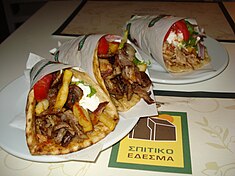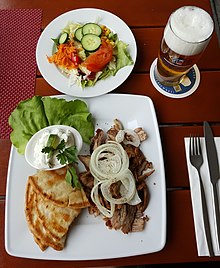Gyros
 | |
| Alternative names | Gyro[1] |
|---|---|
| Type | Meat wrap |
| Course | Main course |
| Place of origin | Greece |
| Serving temperature | Hot |
| Main ingredients | Pita bread, pork, French fries, lettuce, tomato, onions, tzatziki or yogurt |
| Variations | Chicken, beef, or lamb instead of pork |
Gyros, sometimes anglicized as a gyro[2][3][4] (/ˈjɪəroʊ, ˈdʒɪər-, ˈdʒaɪr-/; Greek: γύρος, romanized: yíros/gyros, lit. 'turn', pronounced [ˈʝiros]) in some regions, is meat cooked on a vertical rotisserie, then sliced and served wrapped or stuffed in pita bread, along with other ingredients such as tomato, onion, fried potatoes, and tzatziki. In Greece, it is normally made with pork[5] or sometimes with chicken, whilst beef and lamb are also used in other countries.[6]
Name
[edit]The name comes from the Greek γύρος (gyros, 'circle' or 'turn'). It is a calque of the Turkish döner, from dönmek, also meaning "turn".[7]
In Athens and other parts of southern Greece, the skewered meat dish elsewhere called souvlaki is known as kalamaki, while souvlaki is a term used generally for gyros, and similar dishes.[8]
In Greek, "gyros" is a nominative singular noun, but the final 's' is often interpreted in English usage as plural,[9] leading to the singular back-formation "gyro".[10] The standard Greek and English pronunciation is [ˈʝiɾos]. Some English speakers pronounce it /ˈdʒaɪroʊ/, likely because the word is a heteronym of the unrelated word "gyro".[11]
Similar dishes
[edit]Gyros is made in a similar manner to other dishes such as the Arab shawarma, Canadian donair, Mexican al pastor, and the Turkish döner kebab.[12]
History
[edit]
Grilling a vertical spit of stacked meat and slicing it off as it cooks was developed in Bursa[13] in the 19th century in the Ottoman Empire. After the 1922-23 population exchange between Greece and Turkey, the Greeks brought their variation with them to Greece. Following World War II, gyros made with lamb (called shawarma) was present in Athens.[14][13] It was likely introduced by immigrants from Anatolia and the Middle East.[5][15] The Greek version is normally made with pork and served with tzatziki, and became known as gyros.[16][17]
By 1970, gyros wraps were already a popular fast food in Athens, as well as in Chicago and New York City.[18][19][20] At that time, although vertical rotisseries were starting to be mass-produced in the US by Gyros Inc.[18] of Chicago, the stacks of meat were still hand-made. There are several claimants to have introduced the first mass-produced gyros to the United States, all based in the Chicago area in the early 1970s, and of Greek descent. One of them, Peter Parthenis, has said that the mass-produced gyro was first conceptualized by John and Margaret Garlic; John Garlic was a Jewish car salesman who later ran a restaurant featuring live dolphins.[20]
The Halifax donair in Canada which was based on the Greek gyros was invented in the 1970s by Peter Gamoulakos. Originally from Greece, he started selling Greek gyros (a pita stuffed with grilled lamb and tzatziki) from his restaurant located off the Bedford Highway.[21]
Preparation
[edit]In Greece, gyros is normally made with pork, though other meats are used in other countries.[16] Chicken is common, and lamb or beef may be found more rarely.[citation needed] Typical American mass-produced gyros are made with finely ground beef mixed with lamb.[20]
For hand-made gyros, meat is cut into approximately round, thin, flat slices, which are then stacked on a spit and seasoned. Fat trimmings are usually interspersed. Spices may include cumin, oregano, thyme, rosemary, and others.[citation needed] The pieces of meat, in the shape of an inverted cone, are placed on a tall vertical rotisserie, which turns slowly in front of a source of heat or broiler. As the cone cooks, lower parts are basted with the juices running off the upper parts. The outside of the meat is sliced vertically in thin, crisp shavings when done.[16][22]
The rate of roasting can be adjusted by varying the intensity of the heat, the distance between the heat and the meat, and the speed of spit rotation, thus allowing the cook to adjust for varying rates of consumption.[citation needed]
In Greece, it is customarily served in an oiled, lightly grilled piece of pita, rolled up with sliced tomatoes, chopped onions, lettuce, and fried potatoes, sometimes topped with tzatziki, or, sometimes in northern Greece, ketchup or mustard.[23][24][25]
See also
[edit]References
[edit]- ^ "Gyro Sandwich History". What's Cooking America. 21 May 2015. Archived from the original on 18 January 2022. Retrieved 17 January 2022.
- ^ "gyro". Lexico UK English Dictionary. Oxford University Press. Archived from the original on September 20, 2021.
- ^ "gyro". Merriam-Webster.com Dictionary. Merriam-Webster.
- ^ "Gyro Archived 2022-05-03 at the Wayback Machine". Cambridge Dictionary. Cambridge University Press. 2022.
- ^ a b Simopoulos, Artemis P.; Bhat, Ramesh Venkataramana Bhat, eds. (2000). Street foods. Basel: Karger. p. 6. ISBN 9783805569279. OCLC 41711932. Archived from the original on 2023-03-07. Retrieved 2019-03-17.
- ^ Segal, David (2009-07-15). "The Gyro's History Unfolds". The New York Times. ISSN 0362-4331. Retrieved 2023-11-07.
- ^ Babiniotis, Λεξικό της Ελληνικής Γλώσσας
- ^ Gatsoulis, Joyce-Ann (2006). Night+Day Athens. ASDavis Media Group. ISBN 9780976601302. Archived from the original on 2023-03-07. Retrieved 2019-10-28 – via Google Books.
- ^ "GYRO | meaning in the Cambridge English Dictionary". dictionary.cambridge.org. Archived from the original on 2019-07-14. Retrieved 2019-07-14.
- ^ Francis, Jay (2009-01-09). "Greek 101". Houston Press. Archived from the original on 2021-06-08. Retrieved 2019-10-28.
- ^ Cutolo, Morgan (24 July 2024). "Gyro Food Pronunciation: What Is the Correct Way?". rd.com. Retrieved 16 October 2024.
- ^ Kremezi, Aglaia (2010). "What's in the Name of a Dish?". In Hosking, Richard (ed.). Food and Language: Proceedings of the Oxford Symposium on Food and Cooking 2009. Vol. 28. Totnes: Prospect Books. pp. 203–204. ISBN 9781903018798. OCLC 624419365.
- ^ a b Kenneth F. Kiple, Kriemhild Coneè Ornelas, eds., Cambridge World History of Food, Cambridge, 2000. ISBN 0-521-40216-6. Vol. 2, p. 1147
- ^ "(unknown title)". Sports Illustrated. Vol. 3. Time, Incorporated. 1955. p. 116. Archived from the original on 2023-03-07. Retrieved 2020-10-08 – via Google Books.
- ^ Davidson, Alan (21 August 2014). The Oxford Companion to Food. OUP Oxford. ISBN 978-0-19-104072-6 – via Google Books.
- ^ a b c Kremezi, Aglaia (2010). "What's in the Name of a Dish?". In Hosking, Richard (ed.). Food and Language: Proceedings of the Oxford Symposium on Food and Cooking 2009. Oxford Symposium on Food and Cookery. Prospect Books. pp. 203–204. ISBN 978-1-903018-79-8. Archived from the original on 2023-01-15. Retrieved 2018-10-19 – via Google Books.
- ^ Γιάκωβος Σ. Διζικιρικής, Να ξετουρκέψουμε τη γλώσσα μας 'Let Us De-Turkify our Language', Athens 1975, p. 62, proposes substituting γυριστό for ντονέρ, but The New York Times was already using the word gyro in English in 1971 (4 Sept. 23/1) according to the OED, 1993 online edition, s.v.
- ^ a b Glaser, Milton; Snyder, Jerome (7 December 1970). "Spit and Image". New York. New York Media, LLC. Archived from the original on 15 January 2023. Retrieved 22 January 2024 – via Google Books.
- ^ "The Gyro, a Greek Sandwich, Selling Like Hot Dogs". The New York Times. September 4, 1971. p. 23. Archived from the original on March 23, 2016. Retrieved February 22, 2016.
- ^ a b c David Segal (July 14, 2009). "The Gyro's History Unfolds". The New York Times. Archived from the original on July 21, 2016. Retrieved June 4, 2016.
- ^ corusadmin (2022-04-27). "The Delicious History Of The Halifax Donair". Food Network Canada. Retrieved 2023-08-20.
- ^ Albala, Ken (2011). Food Cultures of the World Encyclopedia. ABC-CLIO. ISBN 9780313376269 – via Google Books.
- ^ Kraig, Bruce; Taylor Sen, Colleen (9 September 2013). Street Food around the World: An Encyclopedia of Food and Culture. ABC-CLIO. ISBN 9781598849554. Archived from the original on 7 March 2023. Retrieved 21 September 2019 – via Google Books.
- ^ "A guide to ordering "gyros" in Greece". Itinari. 26 May 2019. Archived from the original on 12 December 2019. Retrieved 12 December 2019.
- ^ "Great Street Food in Thessaloniki: A Round-the-Clock Guide". Greece Is. 4 July 2017. Archived from the original on 12 December 2019. Retrieved 12 December 2019.
External links
[edit] The dictionary definition of gyros at Wiktionary
The dictionary definition of gyros at Wiktionary



